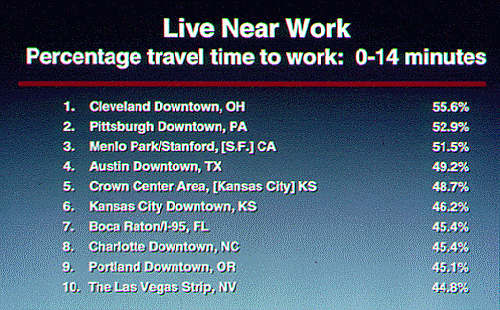Online presentation
Narrated by Joel Garreau

If the point of cities historically has been the creation of
jobs and wealth, Edge Cities are formidable. By this measure The
Schaumburg Area is bigger than Seattle. Like most ports
historically, The O'Hare Airport Area has turned itself into a
major metropolis -- one larger than San Diego. (Next time you come
in for a landing, look for all the high rises.) For that matter,
the Sorrento Valley Area Edge City outside San Diego is larger than
the original downtown -- not an unusual development.


The jobs in downtowns are more likely to be with old, established, Fortune 500 companies. (The Crown Center Edge City is a little unusual in that it is dominated by Hallmark. The Christiana Mall Edge City is a product of Delaware's unusual corporate and banking laws.)


Because Edge Cities are new frontiers, by contrast, they are where you find entrepreneurial start-ups.


Compared to downtowns, which are the products of the Industrial Revolution, Edge Cities are Information Age cities. They are dominated by white-collar professions, the product of which is "cleverness." This is not to say that the old downtowns are dying. Trading centers like downtown Chicago, and university fueled centers like downtown Boston continue to thrive. The District of Columbia, of course, is famous for being a one-industry town.


The people who live within bicycling distance of the tall buildings in Edge City reflect the Information Age education levels of the jobs there.


Throughout most of human history, one of the key points of cities is that people have felt more safe inside them than outside them. Edge Cities are a return to that tradition. The urban cores at the bottom end of this scale are all downtowns and have indexes 2,000 percent higher than these Edge Cities.


Edge Cities are developing distinct personalities. The most kid-friendly urban cores are all Edge Cities, unsurprisingly.


But the places with the least kids that are also marked by couples who are either too young or too old to have kids are those Edge Cities built on top of mellowed, affluent, old-fashioned suburbia. (DINK means Dual-Income, No Kids.)


In contrast to downtowns, the closer you get to the center of an Edge City, the more the residential property values tend to rise. The first law of Edge City location is that when a company moves there, the commute for the chief executive officer always goes down.


For some Edge Cities, this affluence can be a curse. If there is no mix of rents -- if they are all so high that there is no place nearby to house the cops, teachers, secretaries and Xerox repairmen -- an urban core can attrophy. It's difficult to grow a company in southwestern Connecticut, for example, because the grunts have to drive long distances to get to their jobs. Meanwhile, an unrelieved emphasis on country-club style living can make moving a new company into the region prohibitive, no matter what the other advantages are. The Atlanta region's Edge Cities, by contrast, have a much more competitive for example, have a much more competitive mix.


This data surprised us. The whole point of Edge Cities is to reunite people's lives such that they can live near where they want to work, play, shop, pray, socialize and die. However, it appears that living too close to the store can be a mixed blessing. This list of urban cores in which people live very near their work is dominated by downtowns, although the future of Edge Cities may be represented by Menlo Park/Stanford -- the heart of Silicon Valley. (The Las Vegas Strip is also on this list. We don't want to think about what that may mean.) Meanwhile, some of these downtowns are charming paragons of civilization, like Austin and Portland. Others, like Cleveland, Pittsburgh and Kansas City, are struggling despite their theoretically excellent mix of jobs and housing. Go figure.


The Achilles heel of Edge Cities is that in transportation terms, most are still monocultures. They depend on the car. The downside is, if the automobile can't get around, and there's no other choice, bad things happen. This slide shows a very unusual pattern -- in which nine out of the top 10 Edge Cities in a category are all in the same metropolitan area. It is no accident, we think, that the Washington area economy has also slowed dramatically in the last eight years.


The new frontier in Edge Cities, as has been the case in new cities throughout all of human history, is the creation of civilization, soul, identity and community. Urbanity is clearly arriving in these Edge Cities.


Until it has a poet, a place is not a place, it has been said. The muse, meanwhile, is famous for being fueled by wine. But this measure of civilization is extraordinary. Yes, nine out of the top 10 are in Texas. (When the Wall Street Journal called us to ask if we were sure, we replied, "As a result of extensive personal observation, we can report extremely high confidence in this data.")








